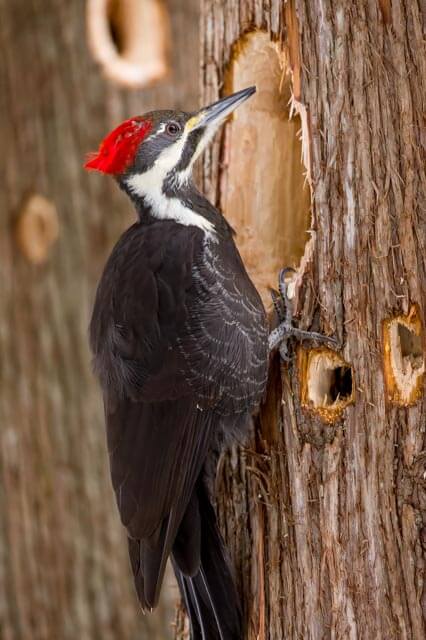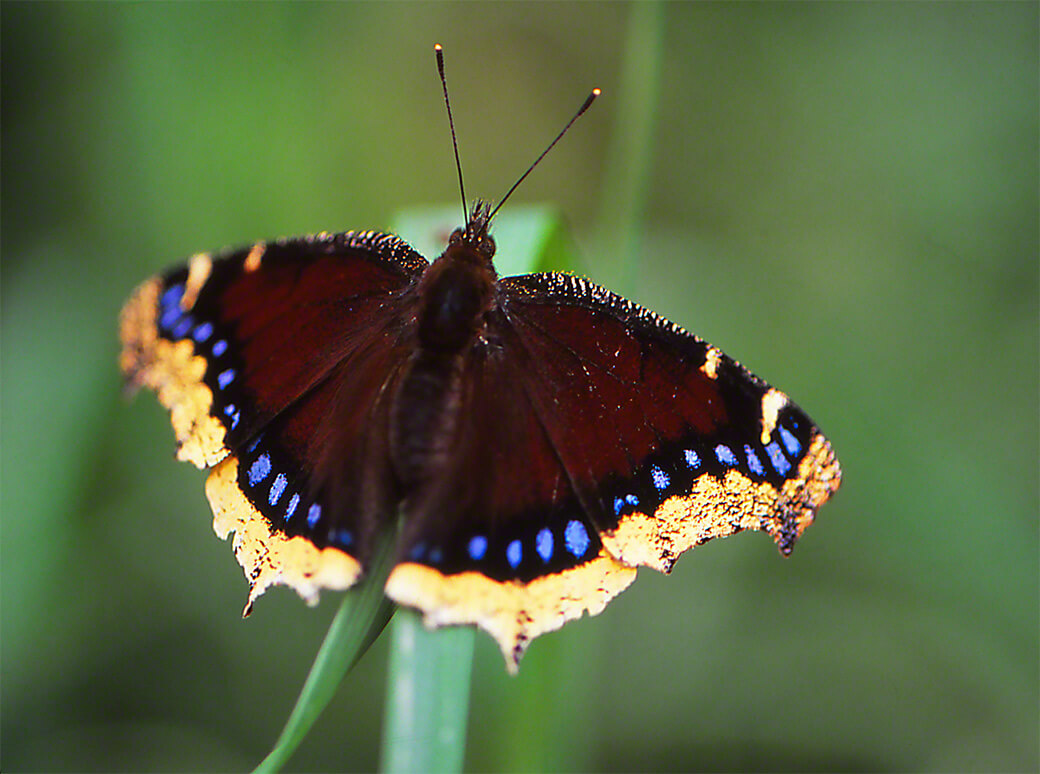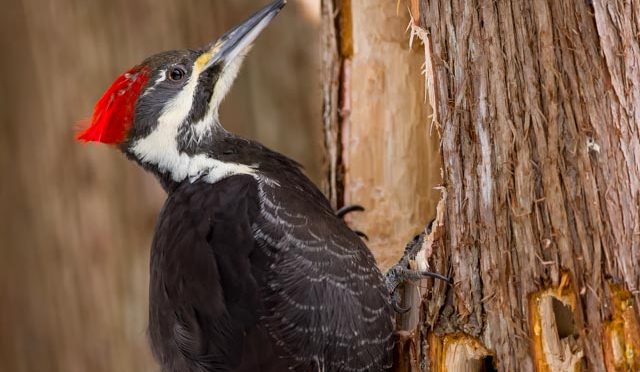Winter 2015/16 Summary
By Tom Estill
In general, the winter of 2015/16 was relatively mild. While both Rocky and Muddy Ponds were beginning to ice over by mid-November in 2014, it wasn’t until the very end of December 2015, that the ponds were just starting to ice over. By the end of Jan. 2016, the ponds had finally completely frozen over. The first major winter storm didn’t occur until the last day of 2015.
Typical birds commonly seen towards the beginning of winter included white-breasted nuthatches, black-capped chickadees, crows and hairy woodpeckers. By the second week of Jan., only a few inches of snow covered the ground. I was surprised to see so many deer and small rodent tracks throughout the whole park. While walking along the Carriage Trail on Jan. 17th, I came across beaver tracks leading from Muddy Pond to Rocky Pond. It got me wondering? More on that later in this summary.

Pileated woodpeckers were heard and seen throughout the forest on a regular basis all winter long. So glad to see their population is holding strong. Only occasionally would I hear or see the tufted titmouse, and dark-eyed juncos. During the third week of Jan., I heard hairy woodpeckers “drumming” for the first time in many months, signaling a change in their territorial behavior. About the same time I followed some coyote tracks up to a small den which I know in the past was occupied by porcupines. Didn’t want to peek inside for fear of disturbing any occupants. By the end of January, warm temperatures had melted so much snow that patches of bare ground could be found throughout the whole park. On Jan. 31st, a golden-crowned kinglet landed on a branch close to where I was sitting, and a tufted titmouse could be heard singing its “peter, peter” song, another bird establishing its breeding territory. One week later, a cardinal was heard singing its territorial/courtship song, a titmouse was heard singing its “Jway” call, and a barred owl could be heard “hooting” deep in the forest west of trail marker #24.
By Feb. 6th, snow was pretty much gone from the park, except for a few isolated and sun-protected spots. Signs of recent beaver chewing activity along the shores of Rocky Pond could be seen from the Shimmer Trail. I also watched three male gray squirrels chasing a female up and down numerous trees until finally, the lead male seemed to get the attention of the female by making various calls to the female, while the other two males sat quietly on nearby branches.
Feb. 14th saw a record cold temp. for that day of -17F, with a -40F wind chill temp. recorded near midnight. While walking through the forest that day, I was amazed at the amount of cracking, snapping, and popping sounds I heard as the sap and trapped water in the trees would freeze, expand and then snap the branches and tree trunks. The second week of Feb. also found me being enchanted by the haunting rumblings emanating from beneath the ice at Rocky Pond, as the ice was shifting and moving with changes in water level, and movement of the water below the ice. Record low temperatures were once again recorded on Feb. 14, while record high temperatures were recorded two days later on 2/16. By 2/17, all signs of snow were virtually gone from the park. On 2/17, I was surprised to easily see from the Shimmer Trail a large, recently built, active beaver den on the West side of Rocky Pond. That explained the beaver footprints leading to Rocky Pond from Muddy Pond I had seen weeks earlier, and all the recent beaver chewing activity seen along the shores of Rocky Pond. Many tree branches were seen poking out of the ice near the den where the beaver had been storing food for the winter months.

First robin was seen at the park on Feb. 20th. And a week later, I received a report of a bald eagle flying near the power lines on the Carriage Trail near Rocky Pond. During the first week of March, mourning doves were heard “cooing” near the trailhead, streams were running ice free, a large beaver was seen for the first time feeding on a downed tree at Rocky Pond, and chipmunks were seen scurrying among the downed trees along the middle Giorgetti Trail. March 13th saw the first butterfly of the season, a Mourning Cloak, one of the first butterflies to emerge from their winter hibernation under the bark of trees, and the first Eastern Newts swimming in large numbers along the shores of Rocky Pond. Both ponds were free of any ice, and moss plants were beginning to grow reproductive stalks. During Feb. and March, I had noticed the water level of Rocky Pond slowing creeping upwards so was not surprised when, walking along the Carriage Trail; I saw a new beaver dam being built at the outlet of Rocky Pond. I’ve been wondering just how big that dam will become in the future?
By mid-March, Canada geese, common mergansers, mallards, wood ducks and kingfishers could be easily seen from the Carriage Trail on Muddy Pond. The last day of winter, I went on a hike through the forest and for the first time in three and a half years, I didn’t see or hear a single bird in the forest, but I did see painted turtle sunning themselves at Rocky Pond, and received a report of a pair of barred owls seen near the intersection of the Carriage Trail and the Redfield Farm trail.
The forest is still relatively quiet, and I wait with great anticipation for the arrival of our spring migrant birds, and the first spring wildflowers.
As a reminder, please respect the No Trespassing/Private Property signs and stay on the trails. Now, go enjoy the arrival of spring at Pine Hill Park.

